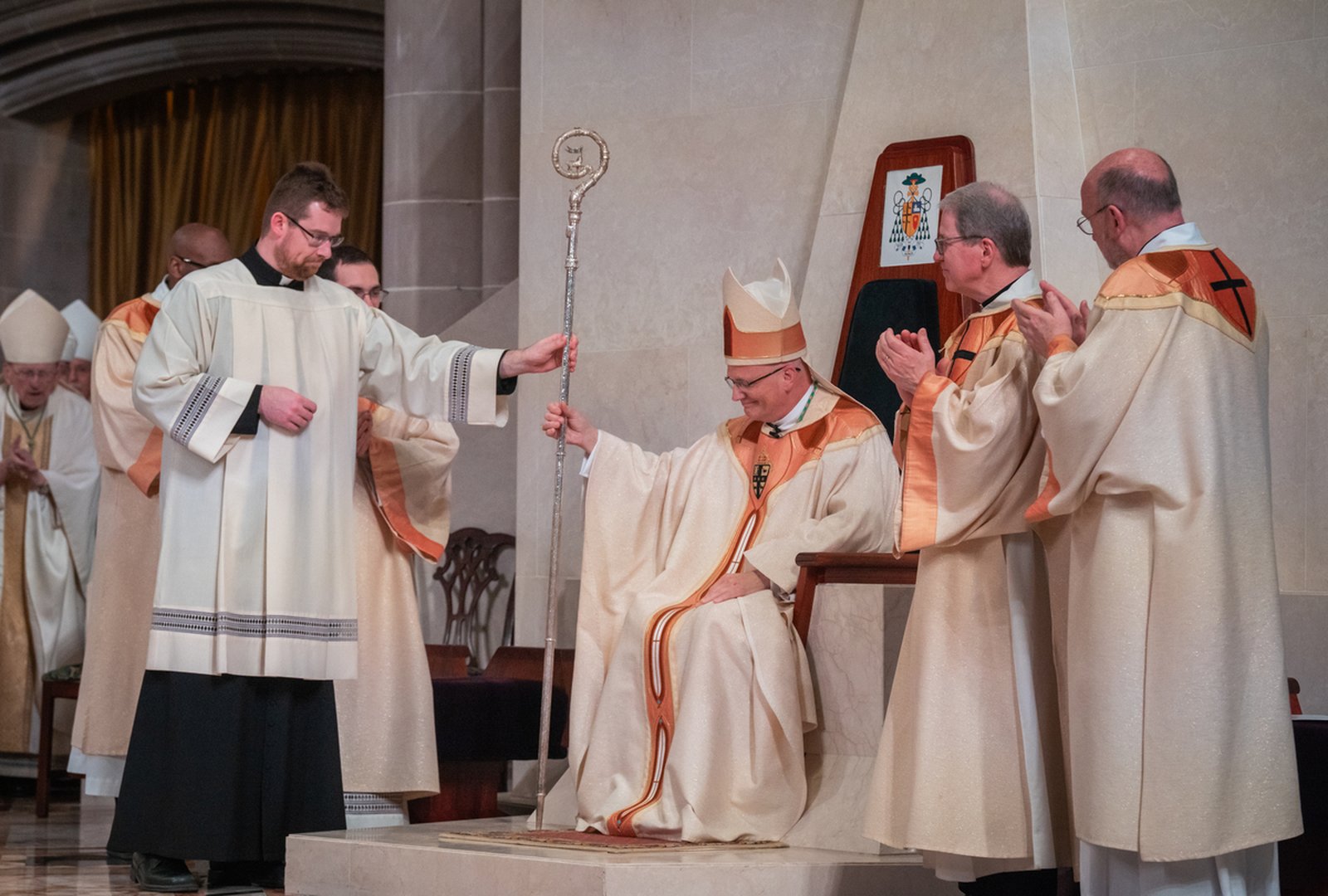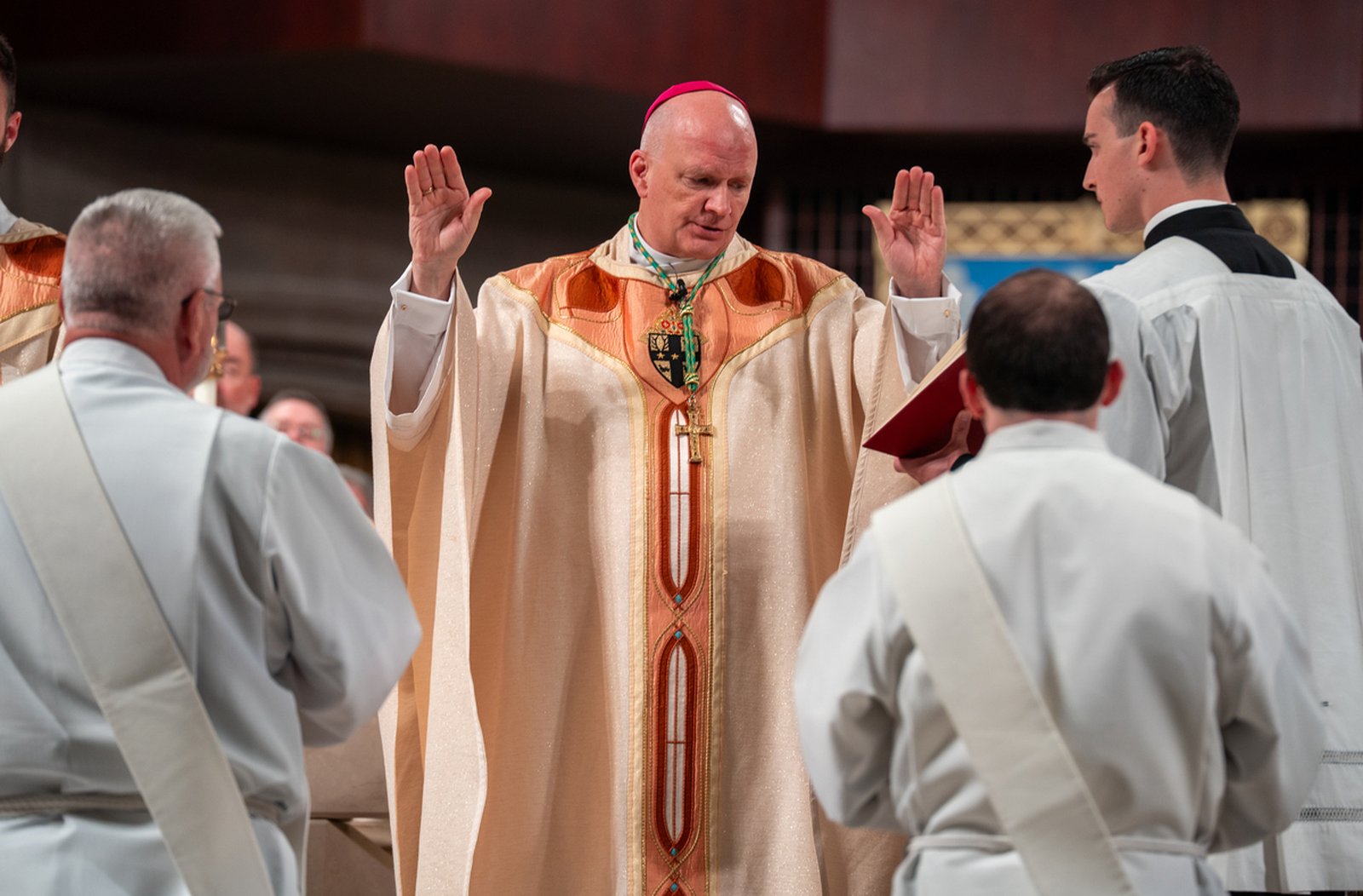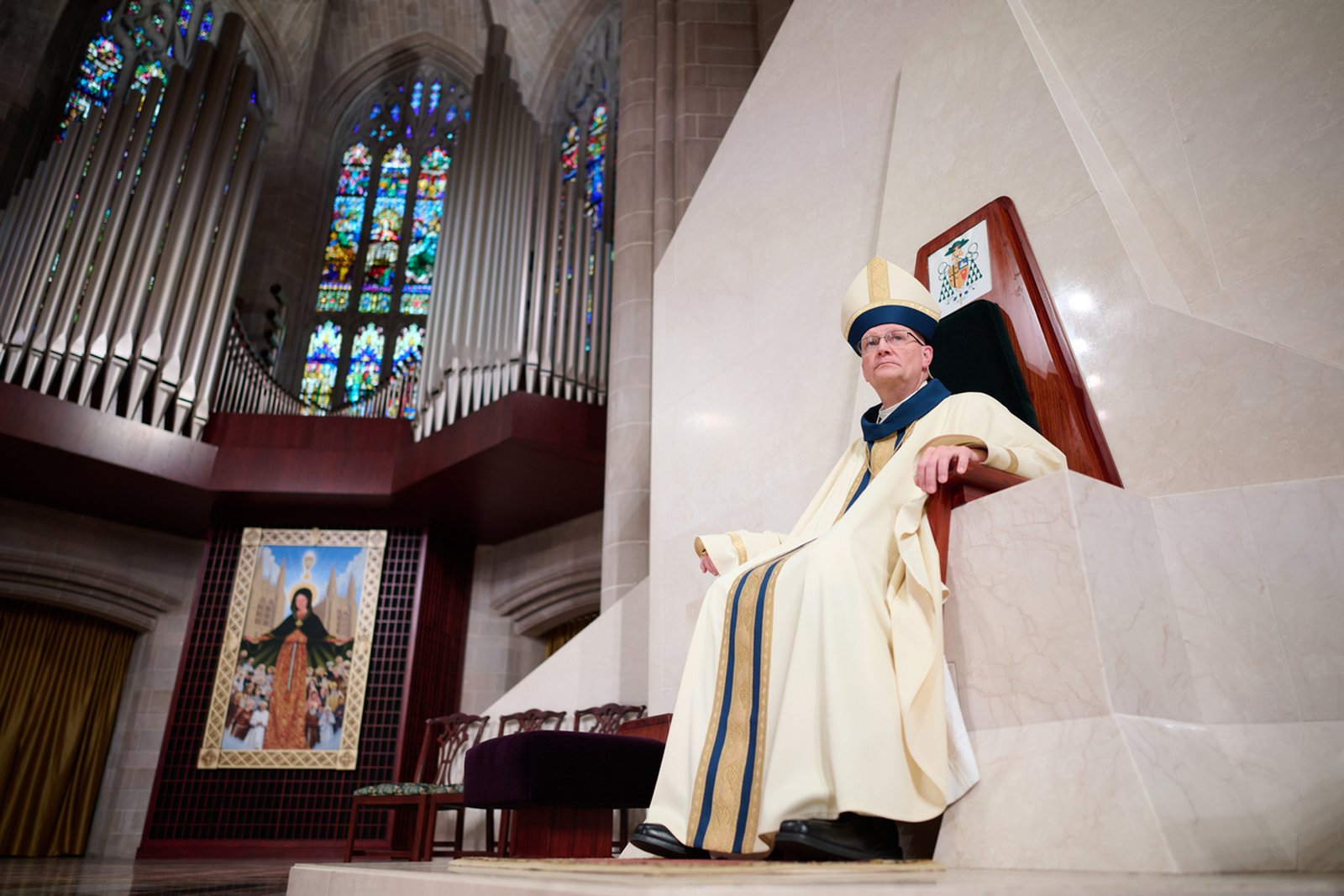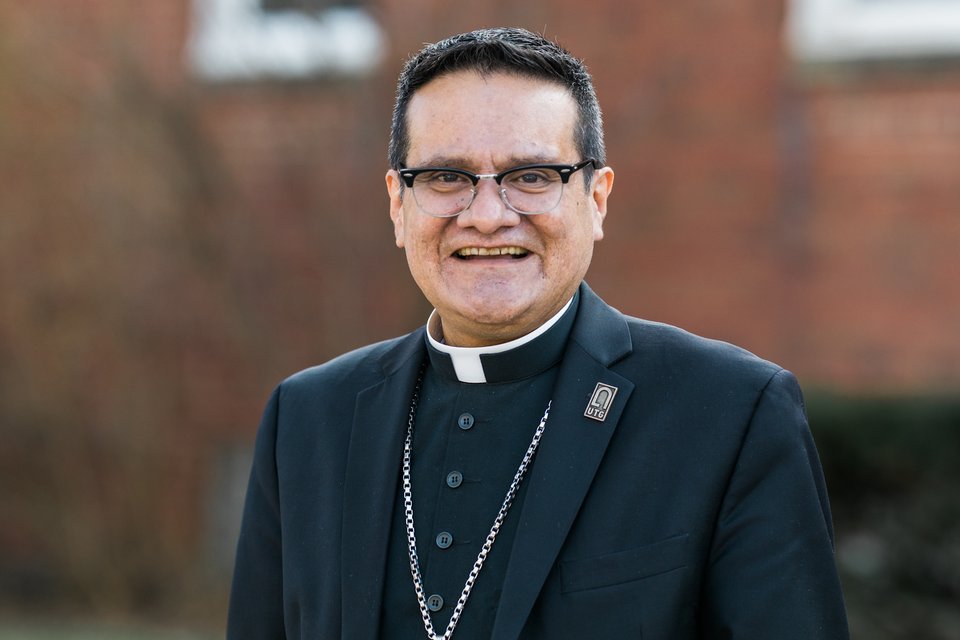Detroit's shepherd will travel to Rome as one of eight new U.S. archbishops as part of custom steeped in ancient Church tradition
DETROIT — On Sunday, June 29, the Solemnity of SS. Peter and Paul, Archbishop Edward J. Weisenburger will be in Rome receive the pallium from Pope Leo XIV, continuing an ancient custom symbolizing an archbishop's pastoral service to his people and his unity with the Petrine office.
Archbishop Weisenburger will be one of eight new American archbishops, along with several dozen newly installed archbishops from around the world, who will be imposed with the pallium by Pope Leo XIV.
Vatican Media will livestream the pallium Mass with Pope Leo XIV from St. Peter's Basilica at 9:30 a.m. Rome time (3:30 a.m. in Detroit) on Sunday, June 29. EWTN will re-broadcast the Mass at noon. A link will be provided on AOD.org.
A 3-inch-wide woolen band with three pins, the pallium — a word that means "mantle" or "cloak" — is a special liturgical vestment signifying the office of the metropolitan archbishop in his ecclesiastical province, a geographic area comprising multiple dioceses. Metropolitan archbishops wear the pallium when celebrating Mass within their province.
In the United States, ecclesiastical provinces often coincide with state lines. The ecclesiastical province of Detroit covers the Archdiocese of Detroit and the six suffragan dioceses in Michigan.
“It symbolizes both my communion with the Holy Father and also my fraternity with the other suffragan bishops, the rest of the bishops here in the state of Michigan,” Archbishop Weisenburger told Detroit Catholic in an interview before he travels to Rome next week.

Archbishop Weisenburger, who was installed March 18 as Detroit's sixth archbishop, will be joined by a contingent of 30 pilgrims from the Archdiocese of Detroit and beyond who will witness the pope impose the pallium on the archbishop's shoulders in a ceremony during Mass, which truly demonstrates the global nature of the Church, said John Hale, president of Northville-based Corporate Travel Service, which is organizing the pallium-centered pilgrimage.
“We have been blessed for the past 20 years to serve most of the sitting archbishops and cardinal-archbishops throughout the United States with a pallium pilgrimage for their contingent,” Hale told Detroit Catholic. “It’s always been a privilege to attend many of these Masses because you really see the universal Church."
The pallium is an ancient Church tradition dating back to at least the sixth century. Historically, two lambs have been blessed on Jan. 21, the feast of St. Agnes, and sheared as Easter approaches, with their wool used to sew the pallia. The care of the lambs is entrusted to a group of Benedictine nuns.
Today, because so many metropolitan archbishops are installed every year, the wool from the two lambs is incorporated with wool from elsewhere to make each pallium.
The white pallium, adorned with six black crosses and three pins, is worn over the archbishop's shoulders and has two 14-inch strips going down the front and back. The pins, called spinulae, represent the nails or thorns from Christ's crucifixion.

The pallium is meant to symbolize the laying of the lamb over the shoulders of the shepherd.
“It’s really a symbol of the authority and pastoral duty of the metropolitan archbishop over their flock, and to shepherds for the sheep,” Hale said. “It's a reminder that we are all connected spiritually back to our mother Church and the Holy Father and the magisterium of the Church. With the laying of the pallium on the shoulders of the archbishop by the Holy Father, they are sent back to their own archdiocese to be that branch, that extension for the nourishment for the soul of the whole archdiocese.”
This year, Pope Leo will return to the tradition of imposing the pallium himself. In 2015, Pope Francis had changed the custom, inviting new archbishops to concelebrate Mass and to receive the blessed pallium from him before returning home to be imposed with the pallium in their home dioceses.
Pope Leo’s imposition of the pallium upon Archbishop Weisenburger's shoulders during a Mass on June 29 at St. Peter's Basilica is the highlight of an eight-day pilgrimage to Rome that Corporate Travel has organized.
Other highlights will include a visit to the Basilica of St. John Lateran — the cathedral for the Diocese of Rome — and dinner with the ambassador of the Order of Malta, a Catholic lay religious order which is its own sovereign diplomatic entity.
The pilgrimage also will include visits to the Basilica of St. Paul Outside the Walls and the Basilica of St. Mary Major, as well as a Scavi tour to witness the excavations under St. Peter's Basilica, where the bones of St. Peter are entombed.
“The four major basilicas, of course, are a highlight, particularly in this jubilee year of 2025,” Hale said. “We'll have the opportunity to celebrate Mass at St. Paul Outside the Wall, where St. Paul is buried, at St. Mary Major, the fourth-century church, and St. John Lateran, the site of the original Constantine-built church from the fourth century where the Holy See was located before it was first moved to France and then to the Vatican.”

Richard Genthe of Our Lady of Good Counsel Parish in Plymouth will participate in the pilgrimage with his wife, Kathy. He’s looking forward to seeing Archbishop Weisenburger receive the pallium, while taking in the rich history and beauty of the Catholic Church.
It’s also a chance to witness history, the first American pope imposing the pallia on his countrymen for the first time.
“We certainly are looking forward to seeing Pope Leo at this special Mass,” Genthe said. “I believe there are going to be eight new archbishops from the United States, so that is a rather tight group from our country, and then it’s going to be followed by a reception at the North American College to honor the new American archbishops.”
The Genthes have been to Rome before, including in May 2004 on Divine Mercy Sunday when they saw St. John Paul II.
But this pilgrimage will be a chance to accompany their new archbishop as he receives the pallium and to pray for his ministry in the Archdiocese of Detroit.
“We often think of the archbishop in just his responsibilities with the local Church, but the Lord has really placed in his heart a love and care and a call to be constantly beckoning everyone who lives in southeast Michigan to come home to Jesus and really share in his message,” said Genthe, a retired third-generation automotive dealer who serves as a member of the Cardinal Club and the Archdiocesan Pastoral Council. “So, any way we can support him and be a friend, we’re looking forward to really beginning that relationship and letting him know he can count on us throughout his time of service to us.”
Archbishop Weisenburger said he's particularly looking forward to praying at the tomb of St. Peter, the apostle to whom Christ entrusted care of the Church.

“I’ve only been (to the tomb of St. Peter) once in my life, and I’ve been to Rome probably 20 times,” Archbishop Weisenburger said. “You get to see the remaining bones of St. Peter, which are all underneath the basilica; it’s the real origins of the Church. When you look at the history of St. Peter’s, it was a cemetery of early Christians, and all those graves circle around that one grave of St. Peter. It’s really moving.”
For most pilgrims, the iconic locations and historic occasion are perfect settings for the local faithful to unite in prayer with their new archbishop, Genthe added.
“Hopefully, everybody throughout the diocese, even though they are not going to be in person at the pallium Mass, will take some special time on Sunday, June 29, to pray and lift up Archbishop Weisenburger as he received this mantle,” Genthe said. “It’s a great chance for us as a Church to pray for guidance for him, for protection for him and for him to be our good shepherd.”
When asked how the faithful of the Archdiocese of Detroit can pray for him, Archbishop Weisenburger pointed to two specific intentions, as well as for the continuing mission of all archbishops of Detroit, now and into the future.

“Wisdom and prudence,” the archbishop asked. “But beyond me, pray for all my successors into the distant future — and by that, what I really mean is vocations.
“It’s kind of a theme for me,” Archbishop Weisenburger added. “We really need always to be praying for vocations, to the priesthood and religious life, especially. They are the backbone. In fact, the spinulae — those pins to hold the pallium — can also be translated as spine. Perhaps it’s our vocations that are the spine, the backbone of our Church.”
Detroit Catholic editor-in-chief Michael Stechschulte contributed to this report.
Copy Permalink
Bishops












